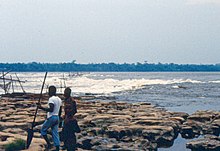Boyoma Falls
The Boyoma Falls (formerly Stanley Falls ) are a series of seven rapids on the upper reaches of the Congo . They are located in the Democratic Republic of the Congo between the cities of Ubundu and Kisangani (also called Boyoma ).
The cases were first described by the Africa explorer Henry Morton Stanley . They were named after this until the end of the 20th century.
In the first and seventh cataracts, the river climbs almost 5 meters, the other rapids are lower. Overall, the cataract stretch is a good 100 kilometers long and has a height difference of around 60 meters. Since the Itaipú power plant overflows the Sete Quedas Falls of the Paraná , the Boyoma rapids have often been referred to as the most water-rich falls in the world. Like these, they have an average flow rate of around 17,000 m³ / s. However, the term waterfall does not apply to the Boyoma cataracts.
These non-navigable rapids, often referred to as waterfalls , form the border between the upper reaches of the Congo , which is called Lualaba up to that point, and the middle section of the river through the Congo Basin , which ends above the so-called Livingstone Falls. Between the ports of Ubundu and Kisangani, a railway line closes the gap in the shipping route created by the rapids. The rapids are of particular economic importance for the fishermen called Wagenya , who usually fix wooden trap - like structures in the middle of the raging reefs .
See also
Web links
Coordinates: 0 ° 29 ′ 28 ″ N , 25 ° 12 ′ 23 ″ E

